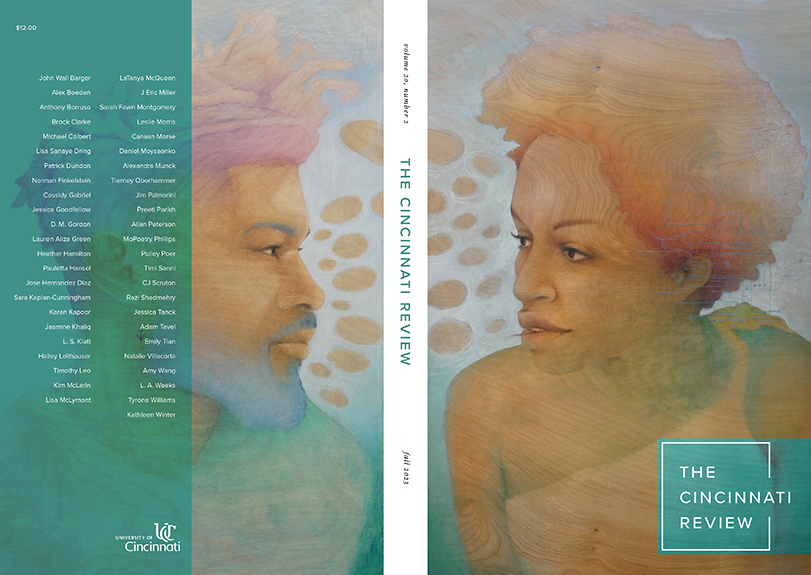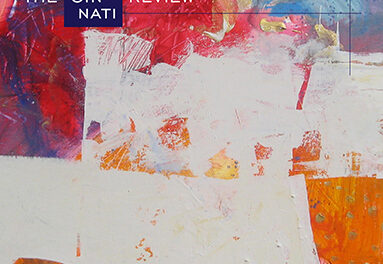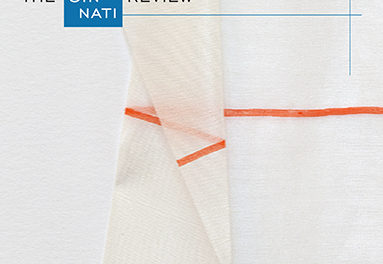If her head gets cold, it starts to hurt, so on days when the sun cannot dry her hair on the short walk from the sea to Grandma’s house, Alfhild’s father massages her scalp until her thin, little body stops shivering under the towel. It has become a routine, a ritual almost; Alfhild finishing her late-afternoon swim with a cup of hot chocolate and her father’s warm hands on her head. She stands in the kitchen with her back toward him, the cup of hot chocolate close to her chest, her head slightly bowed, her prescription swim goggles fogging in the rising column of steam. There is at these moments something undeniably otherworldly about her: silent and shaking with cold like a delicate sea creature dripping on a linoleum floor, a petite and taciturn mermaid, doing her best to adapt to life on dry land. The act of massaging her scalp is, to Alfhild’s father, a way to ease the transition. If he finds a ribbon of seaweed in her hair, he plucks it out and shows it to her as if to say: Look, this is no longer part of you, the sea has let go, you are free to be human again. Sometimes, just to upset her expressionless face, he pretends to pluck other, far more improbable things from her hair: an amber-colored pebble, a chewing-gum wrapper, a coin, a car key, a stainless-steel wristwatch. She looks on in absolute silence, and when his performance comes to an end, she puts the cup down and looks him straight in the eye, holding his gaze for a couple of seconds. Then, with a long exhalation of breath, she claps very slowly.
It is hard not to smile when he sees her like that, ironically clapping while shaking with cold, her goggles still foggy, her pale little face upturned and unsmiling. If it makes her engage, it is good, he argues when his wife, Clara, tells him to stop encouraging this type of behavior. He knows it is strange, unnatural even: a five-year-old girl expressing herself with the undisguised contempt of a teen. Yet the gesture is so perfectly executed, so expertly hurtful, that to see it only in terms of antisocial behavior is to miss something that to Alfhild’s father feels almost miraculous.
Intellectually, Alfhild is a precocious child. She passed the admission test for Mathildeskolen’s preschool program in Ebeltoft with a comfortable margin. She reads at a seventh-grade level, and her active vocabulary would put most adolescents to shame. Still, her program instructors report increasingly withdrawn and aggressive behavior, and one day in March the school psychologist calls. It hits his wife hard, on their way home from Ebeltoft. Clara just sits in the passenger seat with a blank look on her face, mumbling to herself, again and again: It’s not fair, first her eyes and now this, it’s not fair. They go to a specialist in Aarhus, who interviews Alfhild and comes to the same conclusion as the school psychologist. The next doctor they see thinks it’s too soon for a conclusive diagnosis, and for a while they allow themselves to believe that Alfhild is simply going through a phase. After a couple of months, however, with no noticeable change in Alfhild’s behavior, they go back to the doctor and insist on having a genetic test done.
Several abnormalities are found in Alfhild’s genes: presence of PVOX and ZALC3F, mutations in the region involved in Götzman-Carr and Tyro syndromes—confirmed by DNA sequencing of the IRNI2 gene, popularly known as the irony gene. The name is unfortunate, the doctor explains, since fewer than five percent of cases stem from mutations in this particular gene. And once more, the doctor reminds them that an accurate diagnosis requires close observation over a number of years and that frequent irony use in early childhood is not necessarily a predictor of adolescent or adult-onset PIPRAD (Pervasive Ironic Pattern Recognition and Appreciation Disorder). In fact, a former patient of his has scored even higher than Alfhild on the Williamson childhood sarcasm scale; she is now in her twenties, still high functioning with minimal medication and no history of concomitant depression or self-destructive behavior. It’s not the end of the world, the doctor assures them, most conditions can be managed; with an attentive support network, even expressive sarcastics can go on to lead long and, for all intents and purposes, happy lives.
During the following days, Alfhild’s father disappears into a hole of obsessive internet research. He climbs out, pale and unshaven, clutching two facts about the disorder. Fact number one: for those who perceive it to its fullest degree, irony is one of the most exquisite patterns in nature. Fact number two: experienced irony must be expressed. According to a recent Scandinavian study, low communicative output lies at the root of all registered cases of PIPRAD-related self-mutilation. If irony is not continually conveyed, it will build up in the sufferer’s mind and eventually trigger a self-harming event. As parents, the best thing they can do for their daughter is to activate her—that is, create an engaging, target-rich environment and encourage every act of expressivity, no matter how hurtful or cruel.
Clara disagrees. The angry specks of red in her cheeks have already spread to the sides of her neck, and she refuses to meet his eyes when she speaks: You’ll make it worse; if you indulge her, you’ll turn her into a monster.
He tries to explain that maybe with time and the right medication, Alfhild’s output might be controlled, but right now their first priority is to point the edged blades in Alfhild’s mind away from herself. In the online forums it’s often referred to as hugging the razor: the act of draining a loved one’s irony buildup by turning yourself into a target. It’s a demanding procedure. You have to lower your guard and just stand there and take it, arms by your side, letting each cutting insight land unimpeded. For Clara, it’s too much to take in. He looks at her face and chooses not to insist. Together they interview several certified PIPRAD therapists in the Djursland area, and Clara decides on a young psychologist in Ålsø who treats all her patients outdoors, sitting cross-legged on a porch in front of a garden of wave-patterned gravel and a small rocky island with a miniature tree.
On the gravel, next to a flat moss-covered stone representing a turtle swimming upstream, lies a single rust-colored leaf. Alfhild’s father gestures toward it. Go on, Affi-Bee, he whispers as Alfhild stomps through the ripple-shaped pebble formations and kicks the upstream turtle into a low bamboo fence. This is the process: once she has expressed her frustration—disrupted the garden’s symmetrical patterns by upending a rock or writing something obscene in the gravel—she is given a rake and asked to restore the illusion of water. The psychologist shows her how to make pebbles into ripples and waves, and Alfhild watches with what appears to be genuine interest.
Clara is elated. Look at her face, she whispers, nudging him with her elbow. Isn’t it priceless? She looks so serene.He takes his wife’s hand and squeezes. So serene, she whispers again.
After only a month of rock-garden therapy, Clara tells him she wants a fresh start for Alfhild. She has found a school here in Grenaa, a small public school with an inclusive environment—no stigmatizing special-needs classes, no PIPRAD response plans, no irony de-escalation schemes. She won’t be popular, I know, but sooner or later she’ll connect with someone. He worries about Alfhild being bullied by classmates, but Clara insists: She’ll make a connection; you’ve seen how she’s grown.
Above her red backpack her ponytail curves like a comma. He watches her go, first from the gate and then—to conceal his post-drop-off lingering—from the car or the other side of the street. If he doesn’t see her enter the building, if she disappears behind the ladybug playhouse or just melts into the crowd of child-shaped blobs that amass by the sandbox, he worries. He imagines the worst, and when one day she comes to the gate—a teacher by her side, a bright purple bruise on her forehead—he immediately starts looking for suspects, scanning each little face in the crowd for indications of guilt and poor moral fiber.
No, nobody pushed her, the teacher insists. She got up on her own and just continued like nothing had happened, isn’t that right, Alfhild?
In the car he hears himself ask: You know how to deal with a bully, don’t you, Affi-Bee? He tells her to look for a weakness and use it. Lisps. Freckles. Receding chins. Personal tragedy. Nothing is off-limits. She looks at him uncertainly, wincing a little as he touches her forehead.
When she falls again a few months later, Clara takes her to an ophthalmologist who gives her a pair of bifocals and some atropine eye drops to relax her good eye. This, according to Clara, will improve her depth perception and stop her from falling and bumping into things. Alfhild hates the new glasses. On weekends at Grandma’s, when they come back from the beach, Alfhild keeps her prescription swim goggles on for as long as she can. Like a little explorer from the deep blue sea, she sits at the table and stares at her food, her goggles so close to the bowl that the tips of her bangs dip into the soup. Clara gets up. But I’m a seahorse, Alfhild protests, squirming in her chair as her forehead is testily dabbed with a napkin.
Grandma leans forward. Sweetie, she says, making eye contact across the table, seahorses use their mouths to eat.
Alfhild stops moving. No, Grandma. Her voice is low but assertive. A seahorse eats with its hair, just like a jellyfish.
Grandma’s face tightens into a puzzled expression. He tries to explain: She’s right, Mom, a seahorse’s mouth is vestigial. They stun and digest their prey with the long gastric filaments growing out of their backs.
She nods in her who-would-have-thought-it kind of way, and Alfhild adds: A seahorse filament can eat through a clamshell and damage the bottom of a small wooden boat.
This is their ritual, their father-daughter routine: make Grandma believe something odd and amusing and completely made-up. It’s a collaborative effort, both of them adding to each other’s statements, neatly arranging their made-up facts into a tall and teetering structure, building it higher and higher until either it collapses on its own or Clara intervenes, toppling their little cathedral of lies with a simple statement of fact: No, Lily, the gravitational pull of the moon does not cause iron to accumulate in the brain—no, Lily, the front porch is not speaking to the trees in the garden through fungal networks—and no, Lily, seahorses do not sink ships in the Kattegat Sea.
His mother’s reaction is always the same: hand-over-mouth surprise followed by a laugh at her own gullibility. She looks at them both, smiling and shaking her head, then she turns to Clara and touches her arm: Thank you, honey. I’m so glad you’re on my side. Just look at those two, can you imagine what they would get up to if you weren’t here?
. . .









